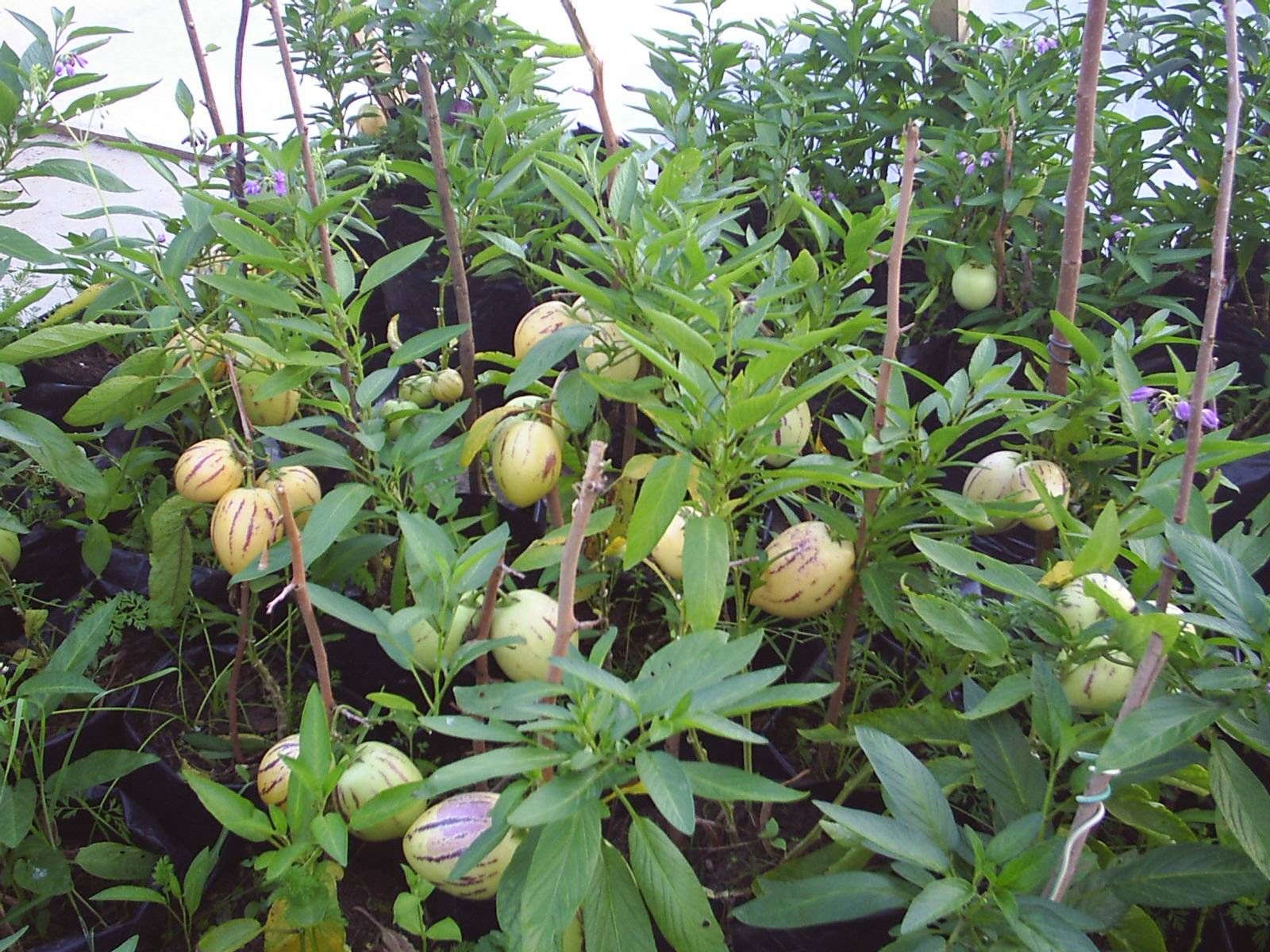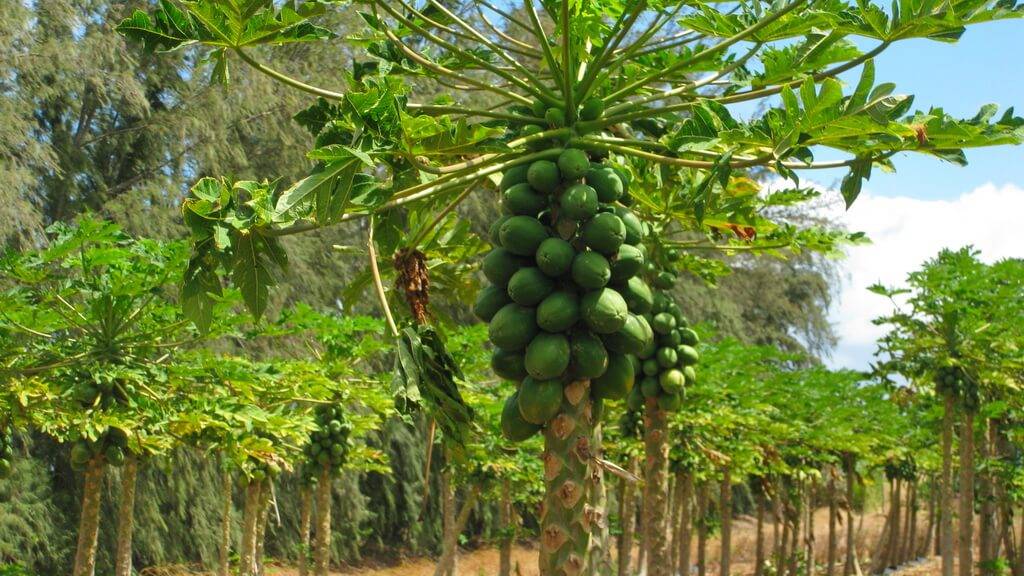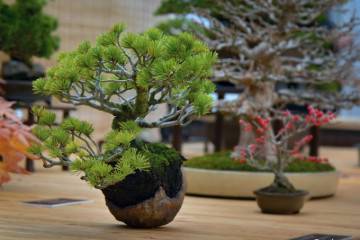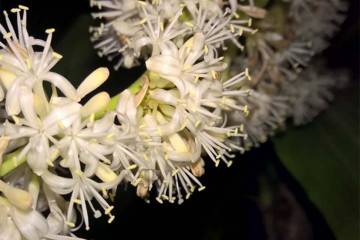Melon tree - what fruits and where it grows
Content:
Today you will not surprise anyone with the presence of various exotic plants on the windowsill. Florists grow orange trees, kiwis and even bananas. The melon pear, melon tree, or pepino also spread to window sills and backyards.
What is pepino, what does the fruit of a melon tree look like?
Pepino was first cultivated more than seven centuries ago by the Indians of Central and South America. Thanks to the work of breeders, varieties have been developed today that take root in Central Russia. The plant reaches a height of one and a half meters, and its shoots are similar to the tops of potatoes, tomato, eggplant. Leaf shades range from light green to rich dark colors. The tops of the shoots are crowned with inflorescences of buds, each of which collects from 10 to 20 pieces.
Depending on where the plant is grown, the fruit can be of different sizes. By weight, pepino berries can weigh from 60 g. The largest fruits are recorded weighing 1 kg 300 g. The shape of the fruit is different. They can be round, pentagonal, flattened, pear-shaped or egg-shaped. The color of ripe fruits has shades of yellow. Purple longitudinal stripes may also be present. The berries reach 17-20 cm in length, up to 12-15 cm in diameter.
If the plant is grown in sunny conditions, the berries are fully ripe and have a juicy and tender pulp, sweet taste and pleasant aroma. If pepino is grown in a shaded place, then the fruits practically do not ripen and taste like a cucumber.
Papaya
Papaya is a close relative of pepino. However, the way they grow is very different. The fruits are similar in taste.
Recently, studies have been conducted on whether papaya seeds can be eaten, and scientists have come up with unexpected results: they can be used as a seasoning and nutritional supplement. Crushed papaya seeds taste like black pepper.
Florists are gradually mastering ways to plant papaya at home. A large number of life hacks have already been invented, how to grow papaya from seeds, what conditions it prefers and whether it will be able to bear fruit. The process is definitely fun and rewarding.
Melon tree varieties for cultivation in Russia
Some gardeners grow melon pear, pepino in their backyards. However, the growth process takes much longer than the cultivation of its relatives: tomatoes, eggplants, potatoes. The fruits ripen 4-5 months after planting. At temperatures above 25 ° C, the fruits are not tied, therefore, for successful growth on the territory of Russia, it is necessary that warm weather without sharp temperature fluctuations stood for about six months.
For 2019-2020 the most common melon varieties are Pepino Consuelo and Pepino Ramses. The Ramses variety is the earliest and most resistant to external stimuli such as wind, bad weather, heavy rains. It is also resistant to high humidity and temperature fluctuations. The Consuelo variety is distinguished by its fruit color, it is bright yellow with lilac blotches. The taste is closest to the taste of melon. Both of these varieties can be grown both in the garden and at home. Fruits are medium in size, from 150 to 750 g, their flesh is sweet and sour and juicy.
How to grow pepino at home
The melon tree propagates at home using seeds or by rooting cuttings. Germination is not very high, so more seeds must be used for the reliability of germination. It is impossible to sow directly into the soil, since they are not capable of sprouting in the soil.
Growing pepino from seeds at home
For pepino, growing at home from seeds is a rather complicated process. Initially, you need to soak them for 24 hours in a growth stimulator. After that, the seeds are placed in a soft tissue, moistened and placed in a dark place with a temperature of at least 25 ° C. No need to wait for quick shoots, seeds begin to germinate 3-4 weeks after soaking. When the first shoots hatch, the tissue with seeds is placed in a Petri dish or small container and covered with a glass cover. Then the container is placed under a fluorescent lamp.
It is necessary to constantly maintain these conditions until the formation of cotyledons. As soon as the seeds are peeled off, they are placed in prepared soil. After a while, the seedlings should be transplanted into separate cups. Every 3-4 days the seedling pots should be placed on a south-facing windowsill or illuminated with a lamp.
Growing pepino from cuttings
The method of propagation of the melon tree is widely used by cuttings or rooting of stepchildren. In this case, the pepino is ready to bear fruit much earlier than with the seed method. Cuttings should be prepared in advance.
In late autumn, cuttings must be cut at the top of 10-15 cm in size. 6-7 sheets must be kept on the shoot. Next, the bottom leaves are removed and the cuttings are placed in water. After 7-10 days, a root system is formed on the shoots, at which time the cuttings can be planted in separate pots filled with nutritious soil. In this case, the temperature should be at least 25 ° С, and the humidity should be 78%.
Growing pepino seedlings at home
Before placing the pepino for the winter, it is cut by a third and the pot is sent to a dark place. Watered once a month and a half. Closer to the end of winter, the plants must be awakened. To do this, it is taken out to the light side and at a temperature of 16-17 ° C, moderate watering begins. After a week, the melon tree should be fertilized with mineral and organic substances containing nitrogen.
After 3-4 weeks, shoots are formed on the bush. These stepchildren must be removed from the mother bush and placed in moist soil. In order for them to take root better, in the first 10-14 days they need to be covered with a film or glass cover.
It is also possible to multiply the melon tree by dividing the mother bush.With this method, the adult plant is not preserved, but is completely renewed. The uterine bush is chosen to be the healthiest and strongest. The plant is picked up in the fall and stored in the same way as the finished cutting.
Features of growing a melon tree at home
For the successful growth and development of the plant, it is necessary to maintain an optimal temperature of 25 ° C. If in the summertime the air temperature drops below 13 ° C, then this is detrimental to the bush. If the temperature is above normal, then it will not bring any benefits to pepino either: flowers, leaves will begin to crumble, shoots will become fragile. Such a melon tree will not bear fruit.
You can also place the plant pot on a pallet filled with expanded clay. It is necessary to keep a small amount of water in it so that the plant itself absorbs moisture. It is important that the bottom of the pot does not come into contact with water.
For the successful growth of a melon tree at home, you must place it on the south side. This should be done so that the plant receives sufficient sunlight throughout the day. If it is not possible to use natural lighting, then it is necessary to organize artificial lighting using fluorescent lamps or special phytolamps. The greatest need for the sun comes at the time of germination of seeds for seedlings and rooting of cuttings. Full daylight hours should be at least 16 hours.
Plants need fertilization. To do this, you can use a 1:10 mullein solution. Organic fertilizers are also suitable. The melon tree is fertilized three times:
- during the rooting period;
- during the beginning of the growing season;
- during the formation of the ovary.
For full fruiting, it is necessary to remove stepsons from the plant every 2 weeks. Start pruning when they grow up to 5 cm. It is necessary to cut it at a distance of 1 cm from the main trunk so that new shoots do not form in the same place.
As a rule, pepino is grown in one stem, but in exceptional cases, when both shoots are well developed, you can leave them. At the same time, it is necessary to tie up the grown bushes. This should be done in the same way with the tomato garter procedure. The shoots should not be compressed too much by the rope, but they should be fastened tightly.
The melon tree is a plant that is self-pollinating. But, in order to better set the fruits, the bushes must be gently shaken during flowering. If at the time of flowering the air temperature rises to 28-30 ° C, then the plant will not form an ovary.
Diseases and pests
The melon tree can be susceptible to fungal diseases or rotting of the roots or trunks. They are provoked by excessive watering, as well as high humidity. To avoid this, you need to follow the conditions of care.
Also, the melon tree can affect the bronzing of the leaves. This is a virus in which the leaves turn black and curl. The bush itself does not increase in height, and the fruits are not formed. There is no cure for this disease, so the pepino will need to be destroyed.
Pepino can be attacked by pests such as aphids, spider mites, or whiteflies. To get rid of them, you can use insecticides, but during flowering and fruit setting, these drugs should not be used.
You don't need to be a professional agronomist to get a bizarre melon pear harvest.Caring for the plant is quite simple, and the result will amaze the imagination of anyone, even the most sophisticated gourmet.





















